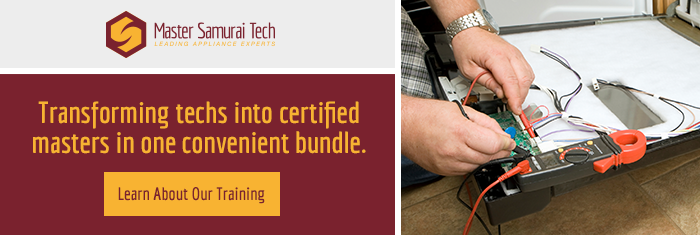I got a great email from an engineer, Iceman, who successfully repaired the thermostat on his Jenn-air range. I was so impressed that he took the time to write up his lab report and send it to me that he has earned a permanent place in the Samurai Hall of Fame. This is great stuff! Here, now, for your grokking pleasure, are the Iceman’s pearls of wisdom on repairing oven thermostats:
Iceman wrote:
Konichiwa honorable Samurai Appliance Repairman.
Jennair Wall Oven: W136W-C
Thermostat: 04100575
AKA Maytag Thermostat 703080
AKA http://www.repairclinic.com/referral.asp?R=154&N=348235Problem: BAKE and BROIL elements stop working
As I was seeking enlightenment in the “Diagnostic & Repair Guide: Ovens & Ranges” for the answer to that immortal question “The bake and/or broil element never gets hot” I was puzzled when I did not see the following possible solution: “The thermostat has failed”.
In reckless disregard of the master’s wisdom, this grasshopper jumped the bake contacts on the thermostat and the bake element changed to the color of the rising sun. Upon removing the thermostat for deeper inspection, all auxiliary contacts were confirmed to operate correctly. However the two primary sets of contacts (the ones operated by the capillary tube of form �Double Pole Single Throw�) (Perhaps BAKE and BROIL contacts?) remained in the off (open) position regardless of the thermostat dial position. By loosening the back of the thermostat thus increasing the clearance slightly between the capillary tube�s push rod and the spring loaded clicker switch, I was able to simulate normal operation (Clicker switch now opened or closed depending on thermostat dial position). I have two questions fearless one, which I humbly submit for your consideration and for the enlightenment of grasshoppers patient enough to read:
1) When a capillary tube based control fails why does it fail open?
I would expect if the fluid leaked out it would fail closed, since a decrease in fluid pressure would simulate a lower temperature resulting in a call for heat (=> closed primary contacts). However the failure mode was definitely that the push rod was longer than it was supposed to be, not shorter, which in this control at least, turns the main contacts off. Perhaps the failure mode is that when the fluid becomes contaminated with oxygen it expands irreversibly. I doubt it. The way it is, it fails safe, so that is obviously the design intent, I just don�t understand the failure mechanism. Perhaps the fluid is still intact and the failure mode is that it turned to jelly. Certainly my vice-grips could not persuade the push rod to reduce its length. Perhaps the push rod just seized. Perhaps it is a mystery not attainable by the untrained mind of a grasshopper�
2) Why is it not possible to obtain replacement capillary tubes and push rods as a single subassembly, or is it?
Surely this would be far less expensive than replacing the entire switch. I was able to remove my capillary tube/pushrod subassembly without damage, so presumably the reverse procedure could be performed just as well. The control was made by Robertshaw, but they do not appear to offer replacement capillary tubes. For that matter, my control is no longer offered for sale by them.
Warning, this procedure involves a high voltage safety hazard, work with one hand behind your back if oven breakers have been turned on (or even if they always were on). Better still, just assume they are turned on:
In any case, may I humbly suggest updating the “Diagnostic & Repair Guide: Ovens & Ranges” answers to “The bake and/or broil element never gets hot” to include �Check to see if your thermostat is hosed up by locating the primary BAKE Contacts, or primary BROIL contacts on the thermostat control and jumping them when the thermostat is in the on position (one pair at a time). If the respective element lights, you have a defective thermostat control. If both light (respectively) when they both did not previously, the defect is likely in the liquid bulb attached to the capillary tube or in the capillary tube itself (not repairable), otherwise the defect is in the primary contact surfaces, which a patient grasshopper can repair by cleaning with wet and dry paper and isopropyl alcohol. Be careful not to lose the tiny ball bearing behind the capillary push rod when you take the control apart (like another grasshopper who is now out $160 did) or your thermostat will never work again.
Arigato gozaimas for your pearls, honorable Samurai Appliance Repairman.
iceman
Domo arigato to you, Iceman!


Dont’ miss the Haiku
http://applianceguru.com/forum3/75.html